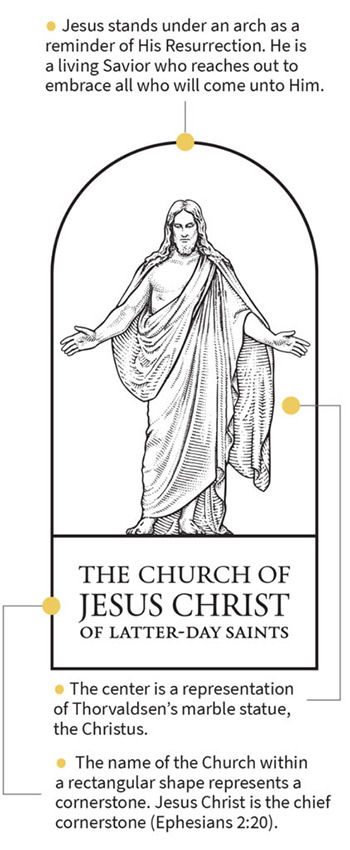3 Key Aspects of the New Church Symbol, Its Purpose, and Use
Contributed By Sydney Walker, Church News reporter

President Russell M. Nelson announced a new Church symbol and explained its significance during the April 2020 general conference.
Article Highlights
- The symbol is a representation, not a logo.
- The symbol is a visual identifier for the Church.
- The symbol represents Christ as the foundation of the Church and His Resurrection.
“[The symbol] will remind all that this is the Savior’s Church and that all we do as members of His Church centers on Jesus Christ and His gospel.” —President Russell M. Nelson
Related Links
As President Russell M. Nelson announced a new symbol to identify The Church of Jesus Christ of Latter-day Saints, he emphasized how it depicts the central place of the Savior in His Church.
“It will remind all that this is the Savior’s Church and that all we do as members of His Church centers on Jesus Christ and His gospel,” said President Nelson during the April 2020 general conference.
The new symbol—which includes the name of the Church in a cornerstone and a representation of Thorvaldsen’s Christus under an arch—“should feel familiar to many, as we have long identified the restored gospel with the living, resurrected Christ,” he said.
Soon after President Nelson’s conference talk, Church members likely noticed the new symbol was added to the Church’s official websites and the Gospel Library app.
The First Presidency and Quorum of the Twelve Apostles are directing how the new symbol is used, and detailed usage guidelines are being developed. The Church’s Correlation Intellectual Property Division has been asked to coordinate implementation.
What is the purpose of the symbol, and how is it being implemented? Here are three things to keep in mind.
1. It’s a “Symbol”—Not a Logo
Eight months into his tenure as President of the Church, President Nelson issued a statement in August 2018 regarding the name of the Church.
“The Lord has impressed upon my mind the importance of the name He has revealed for His Church, even The Church of Jesus Christ of Latter-day Saints,” he wrote. “We have work before us to bring ourselves in harmony with His will.”
During the October 2018 general conference, President Nelson stressed, “It is not a name change. It is not rebranding. It is not cosmetic. It is not a whim. And it is not inconsequential. Instead, it is a correction. It is the command of the Lord.”
There are many worldly arguments against restoring the correct name of the Church, he continued, including digital needs and search engine optimization. But this is the Lord’s Church.
“If this were a discussion about branding a man-made organization, those arguments might prevail,” President Nelson said. “But in this crucial matter, we look to Him whose Church this is and acknowledge that the Lord’s ways are not, and never will be, man’s ways.”
The new symbol is part of President Nelson’s emphasis on the name of the Church and is not a rebranding effort, the Intellectual Property Division reaffirmed. It’s about correct communication.
While a logo is often used to brand products, a symbol represents or stands for something—in this case, the Savior as head of His Church. As President Nelson explained, the symbol is “to help us remember Him and to identify The Church of Jesus Christ of Latter-day Saints as the Lord’s Church.” The symbol “will signify the central place of Jesus Christ in His Church.”
2. It’s a Visual Identifier for Official Church Materials
In introducing the symbol, President Nelson stated that the symbol “will now be used as a visual identifier for official literature, news, and events of the Church.”

The significance of the new Church symbol. Graphic by Church News.
“To avoid confusion and ensure appropriate legal protection, we anticipate that the final guidelines for using the new symbol will be somewhat similar to the current guidelines for the use of the Church logo,” explained Berne Broadbent, director of the Intellectual Property Division.
“Members generally wouldn’t use the symbol, but the Church would use the symbol as a way of identifying official Church material.”
For example, the current policy states the Church logo (the typeface of the Church’s name now found in the cornerstone of the new symbol) should not be used in any personal, commercial, or promotional way, such as a decorative element, a screen saver or background, or on T-shirts, buttons, or banners (see General Handbook: Serving in The Church of Jesus Christ of Latter-day Saints, 38.8.11).
The new symbol is currently being created in 110 languages to serve the more than 16 million Latter-day Saints worldwide. This process includes translating the name of the Church to ensure it fits comfortably within the cornerstone.
With the First Presidency and Quorum of the Twelve Apostles, the Intellectual Property Division is reviewing all materials produced by the Church to determine where the symbol might appropriately be used. This includes materials such as stationery, forms, websites, building exterior signs, and missionary name tags.
3. Honor the Symbol’s Reverence
The Intellectual Property Division is working to educate members to understand the intent of the new symbol. A large part of that effort is a focus on reverence.
The symbol has biblical roots in the Apostle Paul’s metaphor in Ephesians, which describes how the Church is built upon the foundations of apostles and prophets, with “Jesus Christ himself being the chief corner stone” (Ephesians 2:20). Depicting Christ under an arch serves as a reminder of His emergence from the tomb three days after His death.
”There’s a real desire to honor the reverence of the content of the symbol,” Broadbent said. “We wouldn’t be using it in areas that don’t lend themselves to preserving that kind of dignity and that kind of reverence for the Savior.”
He continued, “People love it. They want to use it. They want to relate to it. The guidelines being developed will hopefully help members feel that connection.”
